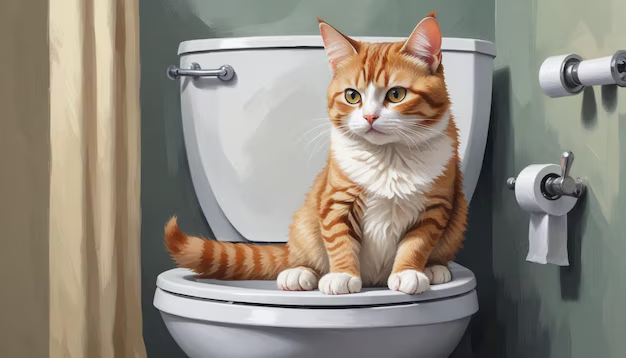Discover the techniques for smoothly moving your cat in only 7 days from a litter box to the toilet. Our detailed instructions make cat toilet training stress-free, simple, and environmentally responsible. The cat toilet isn’t just a fashion–it’s a practical solution for cat owners who want to rise their house’s cleanliness and lessen the environmental impacts. This method will eliminate the necessity of traditional litter boxes cleaning up the mess, and also saves the cost of litter. Although it could seem like a daunting job however, if you follow the correct approach and tools, teaching your cat to make use of the toilet is attainable for the majority of cats.
Why Consider Cat Toilet Training?
The thought of cats with toilets may seem strange at first, however there are many advantages to consider:
- Lower Environmental Impact: Traditional cat litter that is made from clay isn’t biodegradable, and most of the time is disposed of in landfills. If you make the switch to cat litter training it is possible to significantly cut down on the waste that your household produces.
- Cost savings: The recurring expense of cat litter could accumulate over time. After toilet training you won’t have to buy litter, leading to substantial savings.
- Improved Hygiene Toilets are a major source of unpleasant odors as well as bacterial contamination in your home. If you teach your cat how to go to the bathroom in a manner that is clean, you can avoid the problem and have an environment that is cleaner.
- It’s convenient: No more scooping litter or having to deal with litter strewn throughout the home. Once your cat has been trained, it can use toilets just like every other member of the household.
With these advantages that are available, it’s easy to understand why increasing numbers of cat owners are investigating toilet training for their cats as an alternative in lieu of litter bins.
7-Day Cat Toilet Training plan: Step-by-Step Guide
Moving the cat you love transitioning your cat from with litter boxes to together toilets can be completed energetically with a well-planned daily, day-by-day plan. Here’s a 7-day schedule to benefit you complete toilet training for your cat with the diy toilet training kit for your cat or the Cat Toilet Training Kit.
Day 1: Introduce the Toilet Environment
Objective: Make your pet relaxed in the bathroom.
- morning: Put your cat’s trash can near the toilet. Let your cat explore and be familiar with the new layout.
- evening: Observe your cat’s behavior. If they seem relaxed offer them treats and praise. This helps your cat to begin identifying bathroom space with bathroom routines.
Day 2: Elevate the Litter Box
The goal is to Beginning to raise the toilet to toilet-level.
- The morning: Set the box of litter on a sturdy platform, like books, or a stool to lift it just a few inches off the ground.
- Night: Boost the height gradually by adding books or an item. Make sure the box is sturdy to assure your cat is safe while with it.
Day 3: Transition to the Toilet Seat Level
The goal is to Lift the toilet up to the level of the seat of toilet.
- The morning: Increase the box of litter until it’s at the same level as the seat of your toilet. Your cat should be able to jump up to use the litter box.
- evening: Once your cat is always with an elevated toilet, praise them with a treat or praise. Positive reinforcement is vital for a successful toilet training for your cat.
Day 4: Introduce the DIY Toilet Trainer for Cats
Objective: The transition from the toilet to an DIY toilet training intended for felines.
- morning: Replace the trash bin by together the toilet trainer you can make for your cats or an Cat toilet kit. These devices fit over the toilet seat, and typically have a small space to store litter.
- evening: Ensure that your cat is using the toilet effectively by watching their behaviour. Encourage them to utilize the new layout by placing the litter they have used in the trainer’s area.
Day 5: Gradually Reduce the Litter
Objective: Start reducing quantity of litter found in the trainer’s toilet.
- Early morning The amount of litter that is in the trainer for toilets by half. The goal is to benefit your cat gradually become used to together to go in the bathroom without having to use litter.
- Night: Monitor your cat’s behavior. If they are able to use the toilet without litter then give them additional praise or treat.
Day 6: enhance the Hole Size in the Toilet Trainer
The goal is to Help your feline to stand in the bathroom seat.
- morning: raise diameter of hole on the toilet trainer that you make to train cats. This is a way to encourage your cat to stand upon the seat of your toilet when together the bathroom.
- Night: Continue monitoring your cat’s progress, and help in providing positive reinforcement whenever they are together the toilet in a proper manner.
Day 7: Remove the Toilet Trainer
The goal is to Finish this process of training a cat to use the toilet. process.
- morning: Once your cat is confidently with your toilet training device, with more space and less litter It’s time to take it off this trainer totally. Let your cat use the toilet independently.
- Night: Celebrate your cat’s achievement! Keep trying with add positive reinforcement to strengthen the behavior.
Tips to Teach Cat to Use Toilet
Favorably training your cat to use the toilet takes patience, persistence and a few basic techniques:
- Start Slowly:
- It’s crucial not to rush the learning process. Give your cat ample time to get used to each stage prior to going on onto the next. They are animals of routine and sudden changes can create anxiety and stress.
- Be Consistent:
- It is vital to be consistent for bathroom training for cats. Keep a routine in place which includes time for feeding, schedules for cleaning and training sessions. It will benefit your pet feel safe and will be more likely to accomplish success.
- Use Positive Reinforcement:
- Treat your cat with treats, praise or a hug every when they go to the bathroom properly. Positive reinforcement will help cats associate the act with a positive memory, which makes them more likely to repeat the action.
- Keep the Toilet Clean:
- Cats are naturally clean Therefore, it’s important to keep the toilet spotless and the toilet seat clean always. Toilets that are dirty or difficult to access could deter the cat with it, resulting in accidents.
- Be Patient:
- Toilet training for cats is a lengthy process, so it’s important for you to remain patient. Be prepared to take a step back in the event of a need. With patience and time it is possible for cats to be successfully taught to go to the bathroom.
FAQS
How to Train a Cat to Use Toilet?
Teaching your cat to go to the bathroom could cause many questions and worries. This FAQ section will provide answers to many of your most frequently asked concerns:
What can I tell whether my cat is prepared to start the toilet?
Most cats can be trained to use the toilet however, it’s important to determine your cat’s character and health prior to starting. Cats that are younger, usually between 6 months to three years old, are generally more receptive to the process. However older cats and those who have health issues might make appropriate contestants to train their toilets.
What happens happens if my cat won’t go to bathroom facilities?
Cat that isn’t allowing you to go to the bathroom and is not able to use the toilet, you must be patient and take it back to the beginning of the training process. Make sure the toilet set-up will be comfortable to your cat. Additionally, prepare lots of positive reinforcement whenever they do use the toilet properly.
How long will it require to teach your cat how to use a toilet?
The process of training will vary based on the temperament of your cat as well as the consistency you have in your training. In general, it could vary from 3 to 6 weeks, however some cats will take longer.
Is a the cat Kit for toilet training required?
Although it’s possible to teach your cat on its own without an equipment, using a Cat toilet kit can benefit make the process more efficient and organized. Kits like these help in providing an organized method that can guide pet and you through the process of learning.
How can I teach numerous cats to make use of the toilet?
You are able to instruct several cats to make use of the toilet. It is important to train each cat at their own speed. Certain cats might progress more quickly that others. Therefore, make certain to cater for the individual needs of each cat.
Conclusion
A cost-effective and environmentally responsible way for pet owners to cut down on waste in the home, save money on litter, and keep their home cleaner is via cat potty training. Although it may seem like a difficult undertaking, it is completely doable with the appropriate strategy and resources, such as a cat potty training kit or a do-it-yourself cat trainer. The procedure entails introducing your cat to the restroom gradually, switching from a litter box to a toilet seat, and rewarding good behavior at each stage.
Training your cat to use the potty goes beyond convenience. Because there is no longer a need for non-biodegradable kitty litter, which often ends up in landfills, the environmental effect is greatly reduced. Additionally, by minimizing smells and the spread of germs linked to conventional litter boxes, it improves home hygiene. You can effectively train your cat to use the toilet, transforming a common bathroom habit into an amazing accomplishment, with patience, persistence, and a well-structured strategy.














